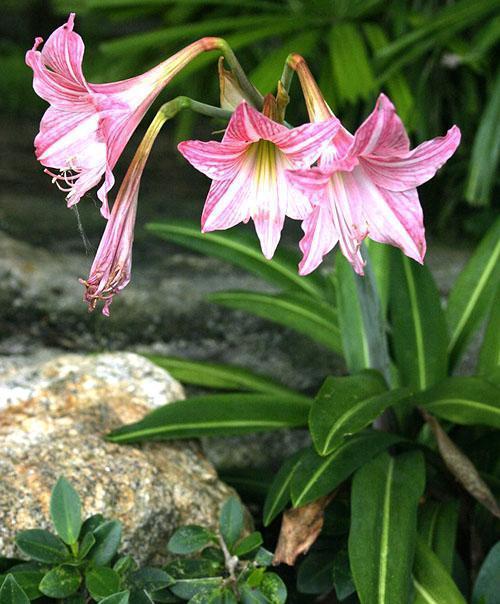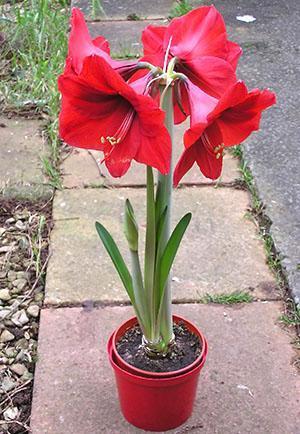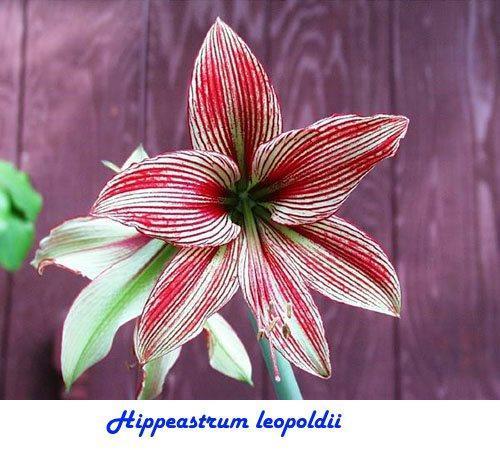Photos of different types of hippeastrum and features of caring for them
 The era of the great geographical discoveries brought the world not only a lot of new knowledge about unknown lands and peoples, but also helped to find and study many families and species of wild plants. One of these cultures was hippeastrum, a bulbous perennial from the South American continent.
The era of the great geographical discoveries brought the world not only a lot of new knowledge about unknown lands and peoples, but also helped to find and study many families and species of wild plants. One of these cultures was hippeastrum, a bulbous perennial from the South American continent.
Since the 16th century, when the first specimens of the plant were discovered, scientists' disputes have repeatedly flared up around the hippeastrum, discoveries were made, and the accepted classification changed. As a result, to date, more than eight dozen species have been discovered and up to 2 thousand spectacular varieties and hybrids have been obtained for growing hippeastrum in the garden on indoor window sills.

But today all new varieties are included in the culture, sometimes outwardly completely unlike the hippeastrum plants familiar to flower growers with ordinary and double flowers of various colors. The diameter of a round or conical bulb, depending on the variety, age and variety, can be from 5 to 20 cm.
Since the plant has pronounced periods of flowering, vegetation and dormancy, you can see how an arrow with 2-6 large buds first appears above the pot, then the flowers open consistently and last up to 3 weeks.
 When flowering is in full swing, and almost all the flowers of the hippeastrum, as in the photo, are open, the growth of elongated dense leaves begins. The subsequent hibernation period, when it may seem that the development and growth of the bulb has stopped, lasts up to three months. In fact, this is the most crucial time, during which the foundation for future flowering is laid and the rudiment of buds and peduncles is formed.
When flowering is in full swing, and almost all the flowers of the hippeastrum, as in the photo, are open, the growth of elongated dense leaves begins. The subsequent hibernation period, when it may seem that the development and growth of the bulb has stopped, lasts up to three months. In fact, this is the most crucial time, during which the foundation for future flowering is laid and the rudiment of buds and peduncles is formed.
 Hippeastrum today is the dream of many amateur flower growers, but only with a skillful approach and knowledge of how to care for hippeastrum, you can achieve regular flowering of the plant and its reproduction at home.
Hippeastrum today is the dream of many amateur flower growers, but only with a skillful approach and knowledge of how to care for hippeastrum, you can achieve regular flowering of the plant and its reproduction at home.
Choosing a hippeastrum garden bulb
 The pledges of abundant flowering and rapid growth of the hippeastrum is a large healthy bulb, which must be carefully examined before purchasing or planting.
The pledges of abundant flowering and rapid growth of the hippeastrum is a large healthy bulb, which must be carefully examined before purchasing or planting.
Good condition and readiness for flowering are indicated by dense, adjacent scales without traces of mold, flabbiness or moisture on the surface. The top layer is composed of dry scales of a golden brown hue.
The roots of a live, ready-to-plant bulb are elastic, healthy, without blackening and signs of decay. If the root system of the garden hippeastrum is dry, damaged by diseases or pests, you must:
- remove non-viable roots;
- generously sprinkle the cut with charcoal and treat with a fungicide.
 The lethargy of the scales signals that the bulb has not yet recovered from the previous flowering, in this case it must be planted in a nutritious soil, providing the plant with proper feeding.
The lethargy of the scales signals that the bulb has not yet recovered from the previous flowering, in this case it must be planted in a nutritious soil, providing the plant with proper feeding.
The health of a plant in a pot is indicated by the elasticity and brightness of the leaves, a dense peduncle and an abundance, as in the photo, of hippeastrum flowers.
How to care for hippeastrum?
 When the plant is actively blooming and then releasing leaves, it will be comfortable in well-lit places, where the daytime temperature varies between 18-25 ° C, and does not drop below 18 ° C at night. For the period of hibernation, the pot is transferred to a cool, dark room. Optimally, the temperature in it is 10-14 ° C, and the air is dry.
When the plant is actively blooming and then releasing leaves, it will be comfortable in well-lit places, where the daytime temperature varies between 18-25 ° C, and does not drop below 18 ° C at night. For the period of hibernation, the pot is transferred to a cool, dark room. Optimally, the temperature in it is 10-14 ° C, and the air is dry.
For abundant flowering, the garden hippeastrum needs bright light, on especially hot days the plant can be shaded, but it is much more painful than the midday sun, this type of bulbous tolerates staying with a lack of lighting.
- The first sign of discomfort will be pallor and lethargy of foliage, stretching and peduncle.
- And when the flower is in the shade during the growing season, the hippeastrum may even refuse to bloom at all, since the bulb will not be able to recover after flowering and gain a new supply of nutrition and energy.
While hippeastrum pleases the grower with foliage and bright flowers, it is watered abundantly, while making sure that moisture does not stagnate and cannot damage the roots. Watering is carried out in a pan or gently under the onion. It is impossible for moisture to get on the leaves and peduncles. After glaze the soil is loosened to avoid the formation of a dense crust.
 How to care for hippeastrum during "hibernation", because the bulb does not show any signs of vital activity? After the last flower withers, the stem is gradually cut off and removed completely when it dries up. At the same time, the frequency and intensity of watering are reduced. The wilting of the leaves is a sign of the termination of the supply of moisture and the plant's readiness to retire. By this moment, the bulb accumulates strength, becomes dense, elastic.
How to care for hippeastrum during "hibernation", because the bulb does not show any signs of vital activity? After the last flower withers, the stem is gradually cut off and removed completely when it dries up. At the same time, the frequency and intensity of watering are reduced. The wilting of the leaves is a sign of the termination of the supply of moisture and the plant's readiness to retire. By this moment, the bulb accumulates strength, becomes dense, elastic.
The duration of the hibernation period is from 6 to 12 weeks, and during this time the bulbs must remain in the dark at a low temperature. Watering is carried out when absolutely necessary, if there is a threat of root drying. In the bulbs of the garden hippeastrum, which gave children, before sending them to rest, the offspring are separated and the plants are seated in separate pots.
 The soil for garden hippeastrum should be very nutritious, moisture-absorbing and loose. The bulbous plant thrives in a mixture:
The soil for garden hippeastrum should be very nutritious, moisture-absorbing and loose. The bulbous plant thrives in a mixture:
- 1 part of sod land;
- 2 parts of humus;
- 1 part quality refined peat.
To reduce the acidity of the soil, bone meal is added to it, wood ash will be a good top dressing, when planting, double superphosphate or complex fertilizer for bulbous plants can be added to the soil. The same agent or any suitable formulation with a predominance of potassium and phosphorus is used to support the plant during flowering and growing season. Top dressing during this period is carried out twice a month.
 The peculiarity of planting hippeastrum is the selection of not only the soil mixture, but also the container for the bulb. If the bulb is in too wide a pot, it will gain weight perfectly, give abundant foliage and babies, but may not bloom. Therefore, the diameter of the best pot is only a couple of centimeters larger than the size of the bulb itself.
The peculiarity of planting hippeastrum is the selection of not only the soil mixture, but also the container for the bulb. If the bulb is in too wide a pot, it will gain weight perfectly, give abundant foliage and babies, but may not bloom. Therefore, the diameter of the best pot is only a couple of centimeters larger than the size of the bulb itself.
For a garden hippeastrum, drainage from small expanded clay 2-3 cm thick is required. Then a cone-shaped soil mound is poured on which the bulb is laid and, spreading its roots, sprinkle with earth. In this case, most of the bulb should rise above ground level.
Since hippeastrum actively producing flowers, as in the photo, require abundant nutrition and form a powerful root system during the season, the plants have to be transplanted after 1-2 years.
 For the summer months, showy bulbous plants are often planted outdoors. In the garden, hippeastrum develop well, and in some cases strong adult bulbs throw out new flower stalks. Florists have noticed that in the open field, bulbs are more likely to form daughter plants, and pollination occurs more often, so that your favorite flower can be propagated not only by children, but also by seeds.
For the summer months, showy bulbous plants are often planted outdoors. In the garden, hippeastrum develop well, and in some cases strong adult bulbs throw out new flower stalks. Florists have noticed that in the open field, bulbs are more likely to form daughter plants, and pollination occurs more often, so that your favorite flower can be propagated not only by children, but also by seeds.
You need to take care of the hippeastrum in the garden or on the loggia in the same way as at home. However, in this case, the following is added to the concerns of the grower:
- the need for thorough weeding;
- plant protection from diseases and pests;
- sheltering landings during a cold snap.
 By locating hippeastrum in the garden, it is easier to track the end of the growing season of the crop and prepare the bulbs for the dormant period. With a decrease in air temperature, leaves begin to wither, watering is limited, and feeding a month before "hibernation" is stopped. Before the start of frost in the fall, ready-for-wintering bulbs are dug out for further storage in a cool place.
By locating hippeastrum in the garden, it is easier to track the end of the growing season of the crop and prepare the bulbs for the dormant period. With a decrease in air temperature, leaves begin to wither, watering is limited, and feeding a month before "hibernation" is stopped. Before the start of frost in the fall, ready-for-wintering bulbs are dug out for further storage in a cool place.
Read also:amaryllis - home care!